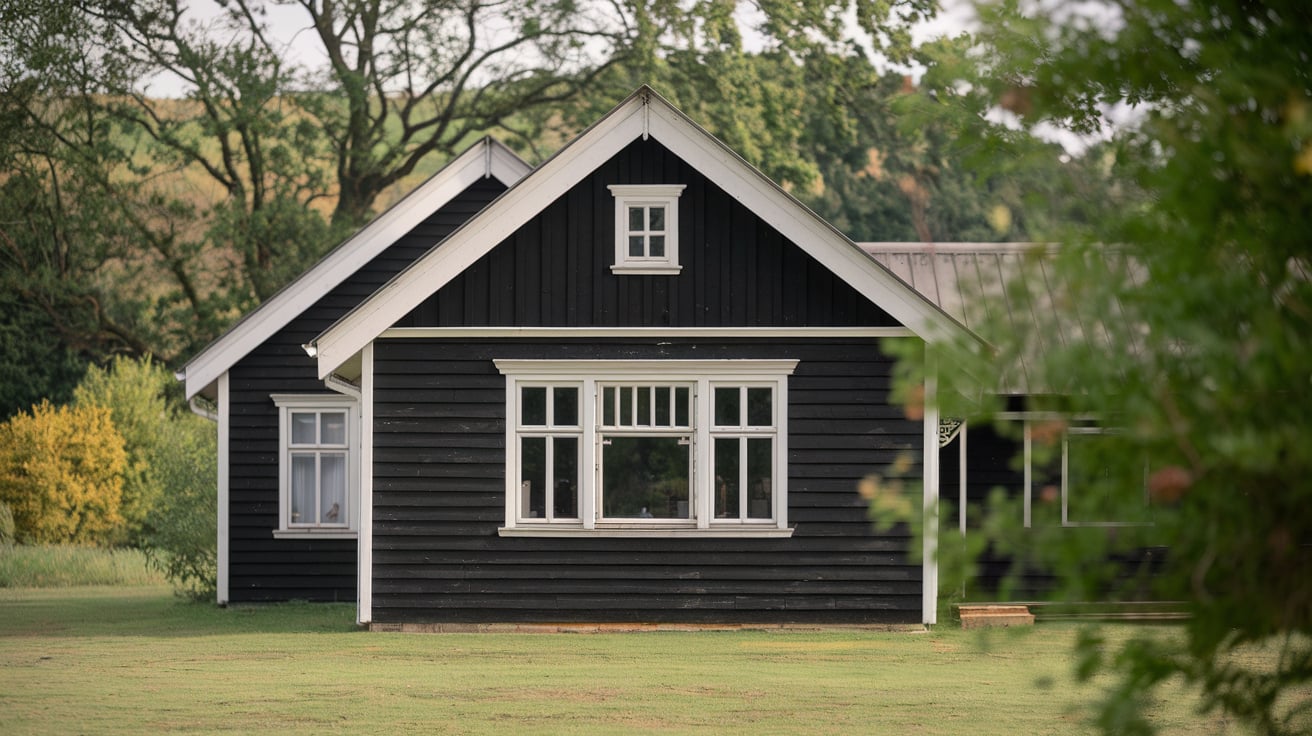Your black house feels flat, missing that special touch that makes it stand out on the street. Choosing the right trim can seem overwhelming.
With countless colors and materials available, one wrong choice could leave your home looking less than its best.
I’ll guide you through selecting trim that brings out the true personality of your black home.
From shade selection to material choices, you’ll learn exactly what works and what doesn’t.
In this guide, I’ll cover everything you need to know about trim for black houses: key factors when choosing colors, proven pairing strategies, material options that last, and mistakes to avoid.
Follow along as I help you find the perfect trim combination.
Understanding the Impact of Trim on a Black House
A black exterior makes your home noticeable and memorable.
Your trim choice serves multiple purposes: it creates visual rest points across the dark surface, directs attention to key architectural features, and sets the overall mood of your home.
Whether you prefer time-honored designs or current trends, your trim selection is key to achieving your desired look.
Choosing the Right Trim Color for a Black House
1. White Trim for a Time-Tested Look
White trim paired with black walls creates clear boundaries that spotlight your home’s structural elements.
This pairing has remained popular through the decades because it works so well.
The clean appearance of white trim brings light and structure to the dark background, making features like windows and doors more prominent.
2. Natural Wood Tones
Raw wood trim introduces an organic feel to a black exterior.
Different wood types – such as cedar, oak, or pine – show unique patterns and color changes that create a gentle transition against the black background.
This pairing suits homes styled with both old-world charm and current-day minimalism.
3. Subtle Contrasts
Medium to dark gray or bronze-tinted trim creates gentle shifts in tone that maintain refinement.
These selections add visual depth without stark changes, resulting in a rich, detailed appearance that highlights the best of your home’s design elements.
4. Distinctive Colors
Consider deep blue, rich green, or muted red trim for a personal touch. These unexpected options add character while keeping the overall look polished.
Success comes from picking shades that work with, not against, your black exterior.
Selecting the Best Trim Material
1. Wood Trim
Natural wood brings genuine beauty with options for paint or stain. It needs yearly care but delivers real character to your home.
Pine and cedar stay popular because they last long and show beautiful natural patterns., and you can choose to wear
2. PVC or Composite Materials
These options handle weather changes well and need little attention. They fight off water damage, bugs, and decay while keeping their good looks. They make sense in places with lots of rain or damp air to resist maintenance.
3. Metal Options
Steel and aluminum choices last long and match today’s house styles. They fit perfectly on homes with straight lines and simple designs, handling tough weather while needing little care.
4. MDF Selection
This material gives you a perfectly smooth look and holds paint nicely. While it costs less and works in many ways, it belongs in covered spots since water can harm it. Good sealing and paint help it last longer.
Pairing Trim with Black House Features
1. Windows and Doors
Could you frame your windows with trim that complements their style?
Double-hung windows might need 4-6 inch trim for proper scale, while picture windows could benefit from wider trim to frame the view. Entry doors often look best with substantial trim that creates a welcoming outline.
2. Roof and Gutters
Your trim should complement your roofing color and style. White trim creates clear sight lines for gray or black shingles, while brown or tan roofs pair nicely with wood-toned trim.
Ensure gutter systems blend with your trim choice—they’ll often be viewed together.
Architectural Details Consider Your Home’s Special Features
- Bay windows might need layered trim to highlight their depth
- Dormers look sharp with trim that matches their angles
- Porch columns benefit from trim that emphasizes their height
- Eaves and soffits need trim that handles weather while looking good from below
Stone and Brick Elements
If your home includes stone or brick sections:
- Light-colored trim can bridge the gap between dark walls and natural stone
- Earth-toned trim helps blend masonry sections with black siding
- Wider trim pieces create clear boundaries between different materials
Popular Trim Styles for Black Houses
1. Craftsman-Inspired
- Wide boards around windows (5-6 inches)
- Built-up trim combinations at corners
- Exposed trim ends that show craftsmanship
- Square-cut profiles that create shadow lines
2. Simple and Straight
- Clean-lined trim without extra details
- Consistent widths around all openings
- Sharp corners with minimal overlaps
- Flush-mounted pieces that sit close to walls
3. Mixed Width Patterns
- Wider trim on main features like doors
- Medium-width trim around windows
- Thinner trim for secondary elements
- Graduated sizes that lead the eye upward
4. Border Designs
- Two-piece combinations that add depth
- Offset layers that create shadows
- Corner blocks that add interest
- Trim patterns that frame wall sections
5. Textural Combinations
- Smooth trim against rough siding
- Grooved trim that adds visual interest
- Weather-resistant trim near ground level
- Different trim textures for different heights
Common Mistakes to Avoid
- Picking trim too thin for your home’s size – small trim can get lost against a black background.
- Ignoring your neighborhood’s overall look – while being different is fine, your home should still feel connected to its surroundings.
- Choosing materials without considering your climate – what works in dry areas might fail in wet regions.
- Mismatching trim styles on different house parts – consistency matters for a pulled-together look.
- Overlooking maintenance needs – Some beautiful options require more care than others.
- Using incompatible materials together – not all trim types work well side by side.
- Skipping proper prep work – rushing installation leads to problems later.
- Forgetting about angles and joints – poorly planned corners stand out noticeably.
Conclusion
Selecting trim for your black house goes beyond just picking a color.
Each choice—from the material to the width to the finish—enhances your home’s overall appeal.
While white trim remains a trusted choice, other options, such as natural wood tones and subtle gray shades, offer fresh possibilities.
When deciding, consider your local weather, maintenance comfort level, and neighborhood setting.
Test samples in different lighting and view them from various angles.
With proper planning and attention to detail, your trim selection will enhance the appearance of your black house and protect it for years to come.
Your black house has unique potential – let your trim choices bring out its best features.


















